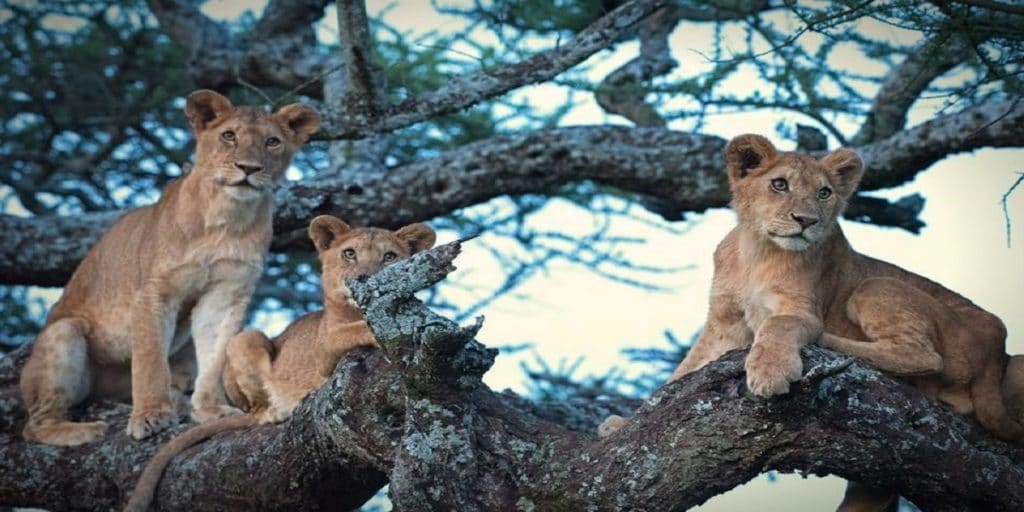
About Tarangire National Park
Tarangire National Park is the most underrated national park in Tanzania. The park is one of Africa’s little-known gems and a must for any northern circuit itinerary.
Boasting a variety of wildlife as diverse as its landscape, Tarangire is also the park that can boast being home to Tanzania’s largest population of African elephants. With four of the Big Five also residing within the park, it is a great spot for a day trip from Arusha or as an addition to a Serengeti or Ngorongoro centred itinerary.
The name of Tarangire comes from Tarangire River which flows through it. The park is an excellent choice during the dry season when animals are forced to move closer and closer to the river in search of water. A backdrop of majestic baobab trees and twisted acacia offers a beautiful experience.
Tarangire NP Fact File
Location: 118km southwest of Arusha.
To Do: Guided walking safaris, game drives, and cultural visits to neighbouring villages.
Known For: Tanzania’s largest elephant population.
Best Time to Visit Tarangire
Beautiful during both the wet and dry seasons, Tarangire is an excellent year round park for game viewing. Between August and October when the wildlife is at its peak, the park offers particularly good wildlife viewing conditions.
Check our Tarangire Tanzania safaris
Park Highlights
Diverse Wildlife
With the exception of the critically endangered black rhinoceros, Tarangire is home to all of Tanzania’s most iconic animals. From the diminutive dik-dik to the towering African elephants and giraffes that attract visitors from all around the world.
In addition to these popular animals, the park is also home to three endangered animals that can be found nowhere else in the country. These animals are fringe-eared oryx with its graceful horns, the towering greater kudu, and the tiny Ashy Starling.
Tanzania’s Largest Elephant Population
Tarangire’s claim to fame is its large elephant population – the largest in Tanzania. During the dry season, herds of up to 300 elephants can be seen digging in the apparently dry riverbed of the Tarangire River looking for underground streams.
Even during the wet season when other inhabitants of the park are able to scatter out across the entirety of the park’s 20,000 square kilometres, elephants remain a common sight thanks to their large numbers.
Migration
Between June and November of each year, Tarangire National Park plays host to a migration. While not as impressive as the Serengeti’s legendary Wildebeest Migration, is nonetheless an impressive sight to see.
As other sources of water dry up, the Tarangire River becomes the park’s sole source of water and draws huge herds of wildebeest, zebras, gazelles, and hartebeests as well as the lions, leopards, and other predators who prey upon them.
During this period, Tarangire offers fascinating wildlife viewing, as its dry landscape makes it easier to spot these large groups of animals on the move.
Swamps
You can find Tarangire’s swamp network in the eastern and southern regions of the park. It offers a vital water catchment and sanctuary for the park’s elephants, cape buffalo, and more than 500 species of bird.
A seasonal swamp that dries up during the dry season, the Tarangire swampland offers intriguing game viewing opportunities. A good place for those wishing to see wallowing elephants, the Silale swamp lions, tree-climbing pythons, and even the rare African wild dog.
Birdwatching in Tarangire
With its wide variety of habitats and food sources, Tarangire National Park is a popular destination for birds and the people who love to watch them.
With more than 550 species of bird – the highest number on all of Tanzania – Tarangire truly is a birdwatcher’s paradise.
The park’s woodlands are home to hoopoes, hornbills, brown parrots, and the white-bellied go away bird as well as game birds such as the helmeted guinea fowl, yellow necked spurfow, and the crested francolin.
Other popular inhabitants of the park include yellow-collared lovebirds, lilac breasted rollers, mousebirds, swifts, striped swallows, starlings, bee-eaters, hammerkops, plovers, Kori bustards, bateleur eagles, steppe eagles, and the gigantic lappet-faced vulture. And that’s just naming a few!
Jamboree Africa can arrange specialty bird watching safaris for those interested. Contact us to find out more.
The Baobab Tree
Alongside the acacia, no plant is quite so synonymous with Africa than the noble baobab. Otherwise known as the Tree of Life, the baobab gets its distinct shape from the fact it can store anywhere between 300 and 1000 litres of water within its bloated trunk. Able to live up to 600 years, these venerable trees are particularly common in Tarangire National Park.
Legend has it that long ago, the baobab trees would roam across Africa on their roots until their movements angered God. He planted them upside down so that they would be forever bound to the one place.
From a more practical standpoint, the baobab is an important source of food for the animals of Tarangire. It has edible seeds and elephants use its bark to sharpen their tusks.
Within the park, you can also see the notorious ‘poacher’s hide’- former hiding place for ivory poachers. During the heydays of illegal trade, it could hide up to twenty hunters at a go.
Kolo Rocks Art Site
Just outside the park are the Kolo Rocks – a World Heritage site proposal that display ancient rock art left by ancient hunter-gatherers, as well as the remains of prehistoric rock shelters.
Check more on Wikipedia.

